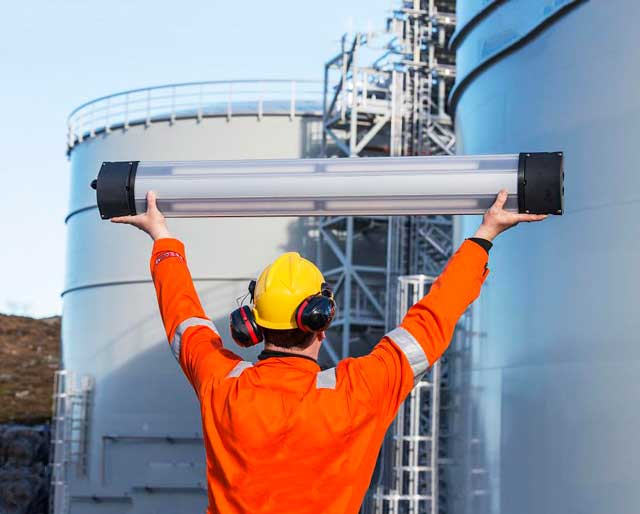
When sourcing lighting for use in potentially explosive atmospheres such as those found on offshore oil platforms or onshore petrochemical installations, it is critical that end users and electrical contractors fully understand the implications on total cost of ownership of that lighting. This means considering the related costs of the lighting throughout its entire lifecycle, including the cost of installation, maintenance, servicing and repair costs. Making a purchasing decision based on the price of the lighting alone is not a prudent approach, particularly as an offshore oil platform has hundreds of individual lights that need installing and maintaining over the life of the platform.
Unfortunately, the high requirements put forward in Ex-type certification don’t guarantee that a light fitting is fit for purpose. In many cases, installation of Ex fittings that suffer from water ingress or that are affected by vibration imposed by site installation causes a significant need for operational maintenance and repair work.
In a hazardous environment, the cost of a non-productive shutdown in order to service or repair failed lighting must also be considered. The more remote the installation the more likely that the costs of maintaining and repairing that lighting will be extremely high.
Buying a less expensive explosion-proof lighting product can often prove more expensive over the long term. Often the purchase price accounts for a relatively small percentage (20-40%) of the overall costs. What’s the point in saving a couple of pounds on the purchase price if this means higher servicing or repair costs due to inferior quality lighting components? Resulting in higher maintenance overheads and a reduced service life of the light fitting? Or lighting failure that results in unplanned downtime, leading to lost production or delayed deliveries?
For lighting designed or selected for a given application, the total cost of ownership is equal to the sum of the following:
Initial cost/purchase price + installation/commissioning costs + energy costs + operation cost + maintenance cost (routine and planned) + downtime costs.
In hazardous areas, these types of purchasing decisions are further complicated by European and International health and safety standards, which allow lighting (and other electrical equipment) to be marked with an ”X” at the end of the certificate number.
According to EN 60079-0, the symbol ”X” is used to denote specific conditions of use. The symbol X is used to provide a means of identifying that essential information for the installation, use and maintenance of the lighting equipment is contained in the product’s certificate. The symbol denotes that the equipment is subject to “specific conditions for safe use”, specified in the schedule to the certificate. The problem is that the symbol may denote an enhancement but could also denote a limitation. This means the owner of the equipment should be aware of the meaning of the X on the lighting in use. It could mean that a risk assessment needs to be carried out on the equipment.
It is therefore essential that engineers understand the subtle technical differences between lighting products from different manufacturers. Although different products may both carry the same ATEX classification, the customer must also consider the possible hidden costs of the ”X” symbol if it appears on the certificate.
For example, take explosion-protected overhead LED lighting installed in a hazardous gas or dust atmosphere. As long as the lighting unit carries the required ATEX classification and test certification, the end user may not be duly concerned with any ”X” marked on the certificate.
The problem here is a common one that many of us can relate to. Conditions of use for a certain product are very rarely published in the glossy product catalogues or flyers. They are normally stated in the product certification documents supplied with the product, which means they are seldom read.
The conditions of use are directly linked to the TCO or lifecycle costs of the product. For example, the end user may have to inspect the light fittings every 12 months, resulting in significant maintenance costs and an increased total cost of ownership. Another example could be a limitation in the ambient temperature of the lighting. Instead of the standard range (-20oC to +40oC) the lighting equipment may be limited for use within an ambient range of 0oC to +40oC. This means that, in effect, the lighting is restricted to indoor use only.
If you do not choose the correct product for the right environment, lifecycle costs can increase dramatically, particularly when additional maintenance is required over and above that required by a similar product.
Glamox supplies a comprehensive range of explosion-protected lighting, including both fluorescent and LED lighting for hazardous areas.

